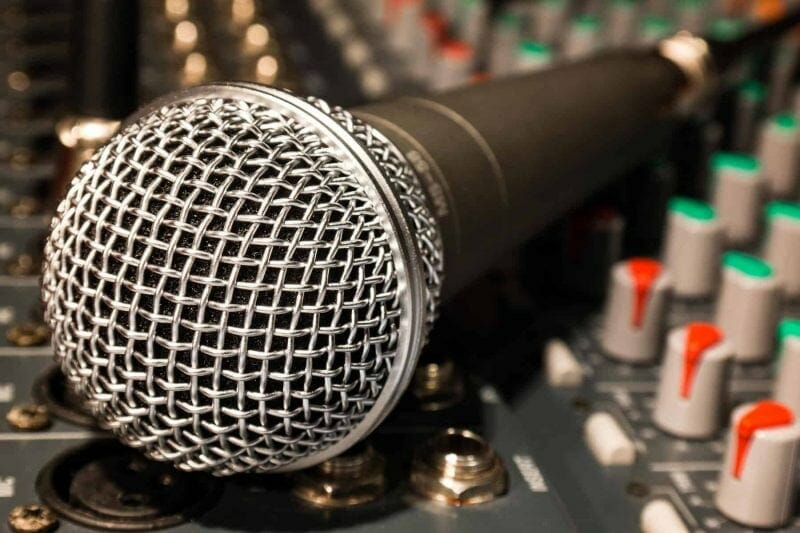The vocals are the most important part of the mix.
Do you know when the quality of your vocals is decided?
In the recording phase.
Without a good recording, you can’t produce good vocals. When recording vocals, you simply can’t fix it in the mix.
In this guide, I’m going to teach you how to record vocals at home that sound like they were recorded in a multi-million dollar studio.
Recording Studio-Level Vocals (at Home)
There are several stages to a good vocal recording, but the process can be split into three vital sections:
- Preparation
- Recording Technique
- Performance

Without good recording technique, you could make the perfect room sound awful.
Without a good performance, you’re wasting your time.
Skip any of these key ingredients and you are doomed to fail.
NOTE: Here’s a great video on Recording terminology:
Phase #1: Preparation is Key
Choosing the Best Room
Good preparation starts with pre-production. Make sure the song is ready for vocals, and that you have a rough mix ready.
After that, you can start to think about the recording location. Choose a room with lots of soft furnishings, and avoid rooms with lots of hard surfaces or windows.
When recording vocals, you want the room to be as dead as possible. This is for a variety of reasons:
- Reverb is not particularly desirable on vocals, neither are room resonances or reflections.
- Reverb pulls the vocals back in the mix, making them harder to hear. You want the vocals to be in your face right at the front of the mix.
- Lively medium and small sized rooms impose an amateur element onto the vocal. This noticeable reverb can also make it harder to blend in artificial spaces in the mix.
- Pitch correction isn’t as effective when vocals have reverb on them.
- Due to the large dynamic range of vocals, heavy processing is often applied to balance out the volume (in the form of automation, compression and limiting). If the vocals have a noticeable reverb on them, heavy dynamic processing will also affect the reverb and sound unnatural.
But a room can be too dead.
Too much absorption can lead to muffled highs and an unnatural sound. The perfect balance is a room that is absorptive enough to prevent any significant reflections and resonances, but not so dead that the voice sounds noticeably muffled.
So chose a room with a lot of soft furnishings, like a bedroom or living room. Avoid kitchens and windowed conservatories.
Positioning the Microphone in the Room
Next you need to decide a position for the microphone.
There are two rules that you must take into account:
- Don’t position the microphone in the center of the room (due to a buildup of standing waves).
- Position the microphone as far away from walls/reflective surfaces as possible.
The best place to position your microphone considering these rules if just off the center of your room. This means you’re a) not dead in the middle, and b) as far away from the walls as possible.
Take the room below as an example. You want to avoid the red areas when possible.

Treating the Room Acoustics
You don’t need to spend a fortune on acoustic treatment to improve the acoustics of the room and dampen the reverb.
If you have proper acoustic panels, use them to create a temporary vocal booth around the vocalist.
Otherwise, you can use materials lying around your home to absorb some of the sound.
Try mattresses, duvets, heavy curtains and anything else that would absorb a lot of sound. If you shouted into it, how much sound would it absorb? The more the better.
Create a temporary booth around the vocalist if possible.

If that’s too inconvenient, place treatment behind the vocalists head. If you are using a cardioid microphone, this is the area that will affect the sound the most.
If you are using an omnidirectional microphone, place treatment behind and to the sides of the microphone too.
You can learn more about DIY vocal booths in this video:
Choosing a Microphone
It’s important that you test several microphones when recording a vocalist (if you have them available to you).
Matching the microphone to the vocalist will guarantee that you get the best tone for that particular voice.
The standard microphone for vocal recording is a large diaphragm condenser. For 95% of situations, this microphone type will just work.
If you are recording at home, I also recommend that you use a cardioid microphone.
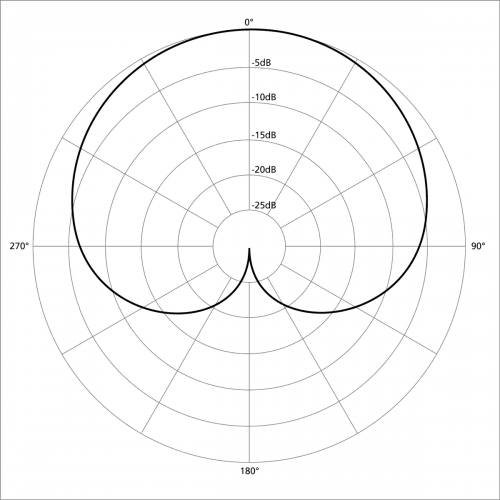
If you are recording in a well treated room, you could also try using an omnidirectional microphone for a different tone. Plus, as there is no proximity effect, the vocalist can move around more and get closer to the microphone for whispery parts.
You can use a dynamic microphone for particularly aggressive vocalist (think hard rock and hardcore music) or to make a vocalist sound warmer.
Dynamic microphones also reject more background noise so are great if you are in a particular bad sounding room.
Make sure you have all the appropriate accessories too. Use a pop filter and shockmount to prevent noise from ruining your vocal recording. Use a strong floor stand that won’t sag half way through the session.
Phase #2: Using The Right Recording Technique
Make Sure the Vocalist Is Happy
Before you start recording the vocals, make sure the vocalist is happy with the monitor setup and mix (always use closed back headphones when recording vocals).
Get some water, a music stand and a stool if appropriate.
Make sure there is a nice ambience in the room – you need the vocalist to feel comfortable. If they don’t, they won’t give a good performance.
UPDATE: We just released a great video on recording giant layered vocals:
Find the Best Microphone Placement
Perhaps the biggest variable in microphone placement is the distance.
Everything you need to know about distance is covered in this video, which I pulled from my Produce Pro Vocals course:
To find the best position for the microphone, some experimentation will be needed.
If this is a vocalist you have recorded for the first time, spend 20-30 minutes trying out different distances and placements if you have the time available.
Getting a great sound at the source is simple. All you need to do is set aside some time to experiment with different distances.
There’s no secret. Most people don’t realise how important this step is.
Microphone choice combined with mic position is 80% of your vocal sound. Skip over either of these steps, and your vocal is going to be a lot harder to mix.
All singers are different. This step will be easier with some than others. After a while you will learn what works and what doesn’t.
If you are pressed for time, you will have to resort to your go-to position. My go-to microphone position is slightly above lip level, pointing slightly downward, at about 6 inches away.
In general, it’s best to bit a bit further away from the microphone when using a cardioid condenser microphone. This is because variations in distance (when the signer starts dancing around) will have less of an impact on the tone and volume when the vocalist is a bit further back.
To stop a vocalist from moving around too much when tracking, you can use a pop shield as a physical barrier for them to reference.
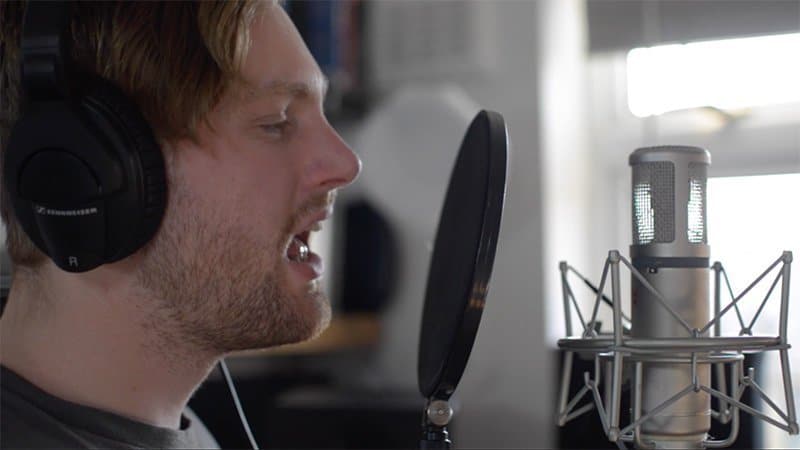
Cardioid Condenser Microphones
With cardioid condenser microphones, you need to remember the proximity effect. In most cases, you don’t want to get closer than 4 inches.
Some old school engineers (like Al Schmitt) will default to around 10 inches. For a modern sound, it’s best to get a bit closer. Start at around 6 inches and experiment from there.
It’s pretty simple, really. The further away they are from the microphone, the brighter the sound will be and the more of the room you will capture. The closer they are to the microphone, the warmer the sound will be and the less of the room you will capture.
Far away (12 inches) = open and airy.
Close (4 inches) = warm and intimate.
If you don’t have trained ears and aren’t 100% confident with your decisions, it’s better to be further away than too close. The proximity effect can quickly ruin a good recording. 6 inches is a good starting point in 80% of situations.
Omnidirectional Condenser Microphones
As omnidirectional microphones don’t exhibit the proximity effect, you can get much closer without affecting the tone.
It’s still better to err on the side of caution and position the vocalist a few inches away – especially if they like to move around a lot.
For quiet, intimate sections you can ask the vocalist to get right up close to the microphone – about 1 inch away (or less). This is a great technique for whispery vocals.
Dynamic Microphones
These microphones are designed to be used up close. The low end is artificially lowered to account for the proximity effect.
For this reason, it’s a much simpler procedure. Simply ask the vocalist to get right up close to the microphone. This works particularly well for aggressive rock vocals (and even screaming).
You can still experiment with positioning the microphone between 6-12 inches away. Some engineers like to use an SM7B at 12 inches – there are no rules. But I generally find that these microphones work best when used up close (as this is the purpose they were designed for).
Microphone Height
Microphone height is another large variable in the tone of the vocal.
High frequencies are the most directional and emit from your mouth in a downwards cone. Therefore, a microphone positioned under lip level will sound brighter than a microphone positioned above lip level.
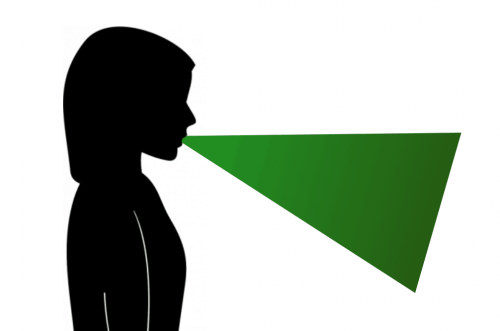
But there is another variable to consider – a lower microphone will also be nearer the chest. This increases the bass response.
On the contrary, as you move the microphone above lip level, the highs reduce as well as the bass. This leads to a more pronounced mid-range.
The go-to height for most people is lip level. This is acceptable in most cases, but can sometimes sound bland and lead to increased plosives and sibilance.
Another technique is to position the microphone a few inches above lip level (at eye level) pointing slightly downwards. This leads to a distinct boost in the lower midrange as we have reduced the bass from the chest as well as reduced the highs from the mouth. That midrange boost can complement some voices and help them to cut through the mix.
This is also a great way to reduce plosives and sibilance. Use a visual aid to stop the vocalist from pointing their head too far upwards and singing directly into the microphone.
I pulled another video out of my Produce Pro Vocals course to show you how much height can affect the tone:
Microphone Position (Axis Orientation)
You can rotate a cardioid microphone to reduce plosives, reduce bass response, increase treble and capture more of the room. Try rotating a microphone 20 degrees to make a small change to the tone.
As well as rotating the microphone, you can rotate the vocalist. Most people have an asymmetrical face, so sound slightly different on either side. Some vocalists will sound slightly better from the right side, for example.
Placing a microphone off axis can significantly reduce plosives and sibilance.
Setting Levels and Recording
Once you have decided on a good position and are happy with the tone, you need to make sure the levels are right on your interface and any outboard equipment (I recommend tracking vocals with some light compression if you have a hardware compressor, but this isn’t essential).
Here’s what you should aim for:
- Averaging around -18dBFS
- Peaking around -10dBFS
- Never peaking higher than -6dBFS
You can see the dBFS level in your DAW on the channel meters (or you can use a dedicated metering plugin).
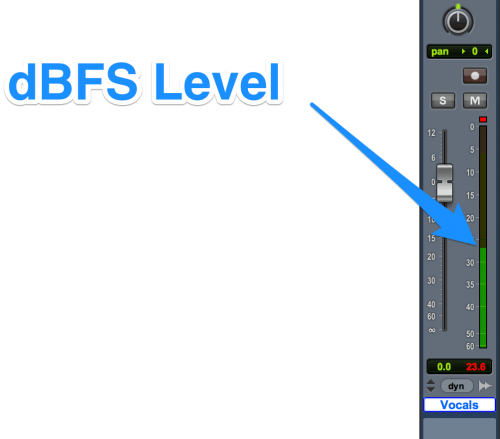
You can read more about setting levels and the gain sweet spot in my recent article on gain staging.
Ask the signer to belt it and adjust the gain until the volume is averaging around -20dBFS (they will probably sing even louder during an actual take, so set the levels a touch lower than necessary).
Phase #3: Getting a Good Performance
When recording vocals, it’s your job to encourage the singer and make sure they are delivering their best performance.
Make sure they feel comfortable and are really getting into the music. Never criticize them during a vocal sessions, and compliment them at regular intervals to increase their confidence.
Ask the vocalist to read back the lyrics and think about their meaning. Ask them to get into the same frame of mind they were in when writing their song.
What emotions were they feeling? Where were they at the time? What was happening that inspired these lyrics?
If the lyrics were written by somebody else, get the vocalist to imagine how they felt when they wrote the lyrics.
Encourage them to lose themselves in the song. And I mean REALLY get lost in it. It often helps to ask everyone to leave the studio.
Take more breaks than you think necessary. Take a 5 minute break every half hour. Set a timer to remind you.
If the vocalist delivers a few bad takes in a row, it’s time for a break. The best takes usually come straight after a break, so take as many as you can (within reason).
Step-by-Step Vocal Recording Checklist
Now that you know how to record vocals at home that sound professional, you need to go away and implement all of this.
It’s useless reading all this information if you never put it into practice.
Here is a step-by-step breakdown of the entire process:
- Before the session, choose a room with very little reverb.
- Use some acoustic treatment. Create a vocal booth out of mattresses or acoustic panels.
- Set up your equipment. Make sure you have all the right accessories. Use a shockmount, pop shield and sturdy floor stand.
- Get a rough headphone mix going.
- Position the singer 6 inches away from the microphone.
- Add a small amount of reverb to the vocal. Use direct monitoring for the dry vocal combined with a 100% wet reverb version of the vocal coming from your DAW.
- Get the vocalist to warm up. Play the song through a few times. Try removing one ear. If the vocalist doesn’t feel comfortable, consider monitoring on loudspeakers.
- Set proper levels (averaging around -18dBFS).
- Apply subtle compression using outboard equipment if possible.
- Go for a full song rehearsal. Record it just in case it’s the best take.
- Tell the vocalist how amazing they are.
- Move a few inches, record again.
- Move close to around 4 inches, record again (just in case, it’s usually better to be further away).
- Listen back – which end of the scale sounds best, close or far? Or does the standard 6 inches sound good? Find a compromise.
- Record 3 full song takes minimum on different tracks or takes (depending on software).
Remember that a good vocal is made in the recording phase. Focus 80% of your energy on recording vocals and 20% on mixing.
This will get you the best results (and mixing will be easy).

Most people overlook the importance of the backing vocals – don’t be one of those people.
Bonus Tip #1: Recording Backing Vocals
You don’t need to spend as long on backing vocals, but don’t underestimate their importance.
Set aside a separate session to record backing vocals if you are using the same vocalist, or at least take a long break after the main recording session.
I like to swap the mic out to get a different tone (try using a darker mic so that the backing vocals aren’t as bright as the lead) but this isn’t essential if you’re running out of time.
Layering different vocalists (rather than overdubbing the same vocalist several times) will always sound thicker and fuller.
The quickest and easiest way is to get great sounding backing vocals is to ask the vocalists to take a step back from the mic. Singing from an extra 6-12 inches away from the mic will give them a more natural, open sound. They will naturally sit further backing in the mix and won’t require as much processing.
This might not work in particularly bad sounding rooms as you will capture more reflections and reverb, but give it a try.
Bonus Tip#2: Recording Ensembles
As with backing vocals, the more singers there are, the further away the mics should be. This will ensure a good balance between singers.
When recording several people it’s worth using two microphones and recording in stereo. Use a matched pair of small diaphragm condensers in an X/Y pattern to avoid phasing issues.

Use the same technique for larger choirs but also add in a pair of microphones using the spaced pair technique. This will widen up the stereo image and capture anyone standing on the far left and right.

Bonus Tip #3: Double Tracking
It’s worth double tracking the choruses or climaxes of the song if you have a skilled vocalist.
Double tracking can also create an interesting effect for bridges and verses when the two vocals are panned hard left and hard right.
For double tracking to be successful, you need a singer who can repeat a phrase almost exactly.
The exact same pitch, the exact same timing and the exact same dynamics. Any fluctuations in pitch and timing can lead to phase issues when mixing.
Record double tracked vocals in almost the same way as the main vocals, but try moving slightly closer or further away from the microphone to create a different tone. This will help to create separation between the original vocal and the double tracked vocal. It can also enhance the stereo imaging when using the hard pan trick (this involves panning the two vocal parts hard left and hard right).
Conclusion
Focus on getting a good sound in the recording phase, and mixing will be easy.
Once you get the vocals right, your overall mix will improve dramatically.

